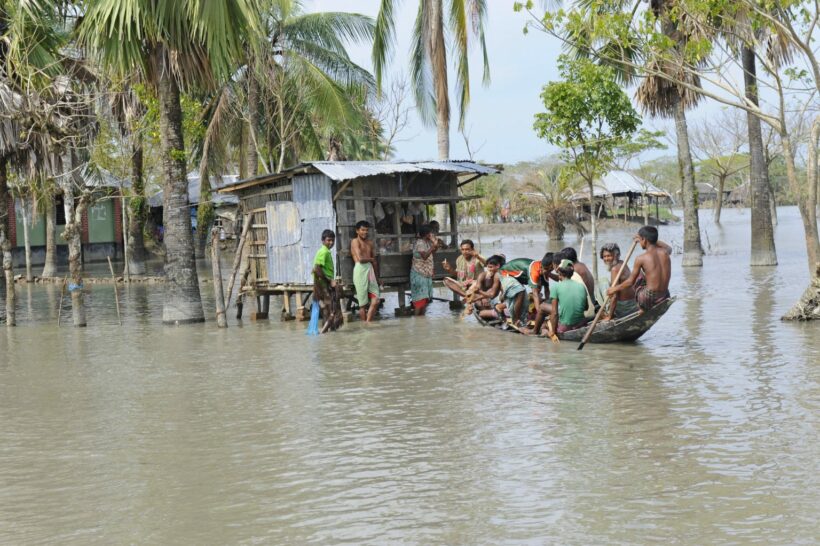Climate change is accelerating at an alarming rate, altering the natural calendar of the natural environment.
By Ibrahim Khalil Ahasan
Crops are not being harvested at the right time, and water salinity and sea level are rising. Heavy rains, non-rainfalls, flash floods and untimely intense fires along with the increase are hitting the poverty line the most. In rich countries, climate change does not affect their socioeconomic conditions as much as it affects poor countries, i.e. South Asian countries. Wealthier countries tend to have the resources and networks to adapt to a changing climate and more resilient infrastructure (such as water systems and housing) to deal with erratic weather events and disasters. Poor countries, however, almost always have fewer resources and poor infrastructure—making them more vulnerable to the effects of climate change. Extreme weather patterns, natural hazards, and food and water shortages threaten the lives of people living in poverty, and poor people find it harder to recover from failed crops, destroyed homes, and health crises. For those in our country who depend on agriculture for income and food, the impact is particularly pronounced. Poor land management policies and unsustainable development are causing land degradation, including soil erosion and desertification—accelerating the negative effects of climate change. And higher temperatures, changing rainfall patterns, and increased water scarcity are making vast areas of land unsuitable for food production. When disaster strikes, those with less power and fewer resources are always the worst hit. But they exacerbate poverty, as those most affected by drought or flood must sell their land or livestock at low prices, effectively transferring wealth from the poor to the rich. It is estimated that, by 2030, climate change could push more than 120 million people into poverty. People in the south are now at the top of the poverty line as climate risks increase in our country. Economists say that people in the southern region are becoming poorer due to climate change. As a result, these regions have to pay more for social protection programs. Policy Research Institute (PRI) Executive Director Dr. Ahsan H. Mansoor said, poverty in the southern region is increasing due to climate change. Salinity is increasing in these regions. Barisal region in particular is highly affected due to climate change, at serious risk. Land salinity is increasing, agricultural production is decreasing.
He said this region is also underdeveloped compared to other regions. That’s why we think that development will happen in these areas. All in all, this region is a poor region. Again Kurigram and Gaibandha are poor areas. There are some natural reasons here. Barisal division naturally falls into that category. Generally, where poverty is greatest, social protection programs need to be greater.
26.9 percent of the total population in Barisal division is poor – which is much higher than the national rate. At the national level, the poverty rate is 18.7 percent. Rural extreme poverty is also the most prevalent. 13.1 percent of the rural extreme poor live in Barisal. In this regard, the situation of the Dhaka division is the best. The rate of such poverty in this category is 1.9 percent. The national rate of rural extreme poverty is 6.5 percent.
Poverty reduction has stalled due to declining personal purchasing power and high inflation. High food prices have particularly affected poor households. These families spend more than half of their income on food. Since the climate is the average state of the weather. The climate crisis problem has been repeating the vicious cycle of poverty for the past few years. Where people want to get rid of poverty, but indirectly get trapped in poverty again. In simple words, from poor to poorer. Due to low per capita income and investment, there is a vicious cycle of poverty again. Moreover, poverty rates are higher in regions or areas where climate change is more frequent. And one of the notable reasons for this increase in our country is the water shortage. Salinity crisis in the southern region, drought in Barendra region and severe water shortage in the Chittagong Hill Tracts. In these areas, people are not getting clean water, there is no water for agriculture. Local corruption and the former government’s infrastructure are also to blame. For chronic poverty, issues such as food security and health disrupt social mobility. Likewise, increasing landlessness is the cause of poverty in Bangladesh. Due to untimely or repeated natural disasters, people have lost their production capacity and labor power due to disease and calamity.
Will the government’s efforts to control the market fail?
As a result, countless people and children are being victimized. 95 percent of landslides are caused by floods and storms. Therefore, poverty alleviation projects must address man-made threats to climate change. The use of fossil fuels should be reduced. To protect the environment, the use of polyethylene should be reduced along with speeding up the recycling process. The poor suffer from a lack of proper healthcare in their areas due to expensive and poor-quality healthcare services. Especially in Barisal division, there is poverty incidence and a low 37.92 percent safe toilet adequacy. Therefore, barriers to construction of safe toilets must be removed.
Changes should be made in the existing farming practices. Especially for the southern region we need to find salinity tolerant crops, fruits and crops. Also, crop insurance is essential in regions where natural calamities occur regularly. Also, building climate change resilient cities will help alleviate poverty from a holistic perspective and take sustainable development one step further.
Ibrahim Khalil Ahasan, a Dhaka, Bangladesh-based independent columnist and freelance journalist, writer on contemporary international issues whose work has been published in many local and international publications.






